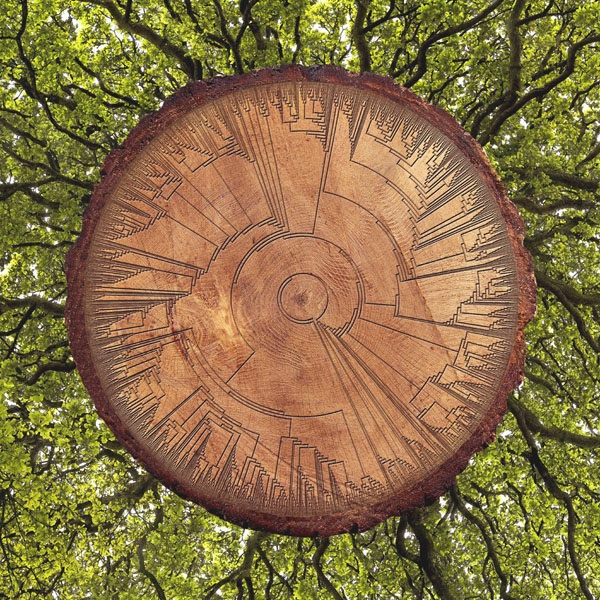| Current Hillis Lab | Visit the Double Helix Ranch | Lab Genealogy | Former Students and Postdocs |
Return to "Download Files" Page
You are welcome to download
the following graphic image of
the Tree of Life for non-commercial, educational purposes:
Tree of Life (~3,000 species, based on rRNA sequences) (pdf, 368 KB)
(see Science, 2003, 300:1692-1697)
This file can be printed as a wall
poster. Printing at least 54" wide is recommended.
(If you would prefer a simplified version with common names, please see below.)
Blueprint shops and other places with large format printers can print this
file for you.
You are welcome to use it for non-commercial educational purposes.
Please cite the source as David M. Hillis, Derrick Zwickl, and Robin Gutell,
University of Texas.
About this Tree: This tree is from an analysis of small subunit rRNA sequences
sampled
from about 3,000 species from throughout the Tree of Life. The species were
chosen based
on their availability, but we attempted to include most of the major groups,
sampled
very roughly in proportion to the number of known species in each group (although
many
groups remain over- or under-represented). The number of species
represented is approximately the square-root of the number of species thought
to exist on Earth
(i.e., three thousand out of an estimated nine million species), or about
0.18% of the 1.7 million
species that have been formally described and named. This tree has been used
in many museum displays and other educational exhibits, and its use for educational
purposes
is welcomed. Below are several adaptations of this figure; my favorites are the two stunning back tattoos
from Clare D'Alberto and Monica Quast. They individually adapted their tattoos
from another version of the tree that I used as a book cover,
which is shown below the tattoos. Below the book cover is a photo of the tree as it was used in an exhibit on
"Massive
Change:The Future of Global Design" (which first opened in the Vancouver Art
Gallery,
and has since appearedin Toronto and Chicago, and is scheduled to be displayed in various venues
around the world). Then, below that is an artist's commisioned work for a hospital, and links
to an interactive version of the Tree of Life diagram with common names.
Tree of Life tattoo, courtesy of Clare D'Alberto, who is working on her Ph.D. in biology at the University of Melbourne.
Notice that this version of the tree is the same one that appears in
Life: The Science of Biology, 8th ed. (D. Sadava, H. C. Heller, G. H. Orians, W. K. Purves, and D. M. Hillis;
published by Sinauer Associates and W. H. Freeman, 2008):
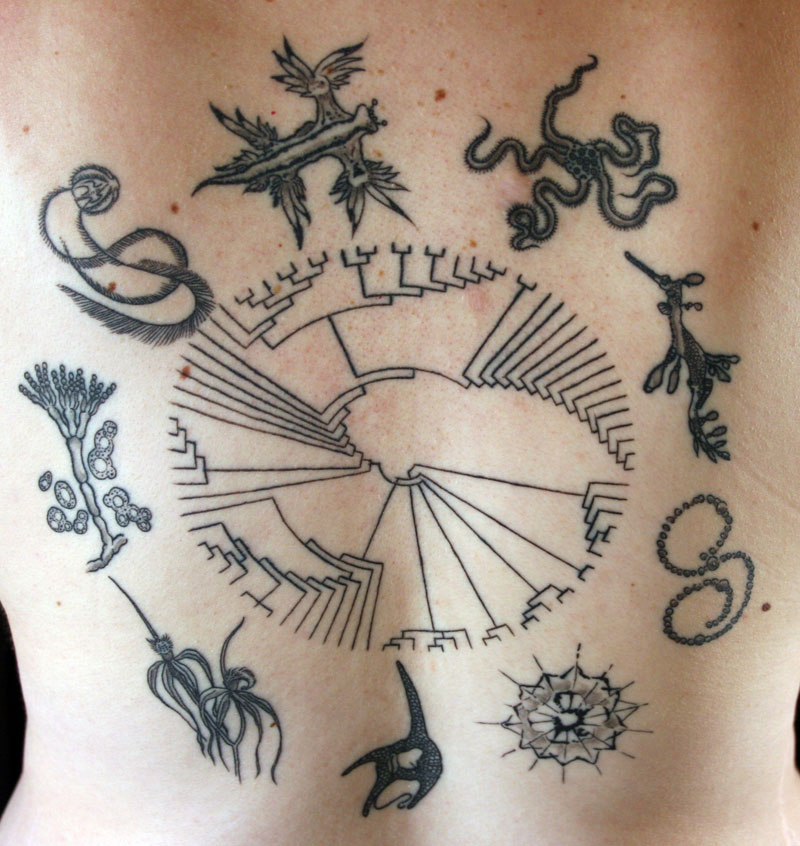
The organisms depicted in this tattoo are (starting at 4 o'clock and going around clockwise):
(1) a cyanobacterium (Anabaena); (2) a radiolarian (Acantharea); (3) a dinoflagellate (Ceratium);
(4) an angiosperm (Spider Orchid); (5) a couple species of fungi (Penicillium and a yeast); (6) a ctenophore (comb jelly);
(7) a mollusc (nudibranch); (8) an echinoderm (brittle star); and (9) a vertebrate (Weedy Sea Dragon).
Here is another great Tree of Life tattoo! This one is courtesy of Monica Quast, who is a Ph.D. student at the University of Campinas, Brazil, working on bivalve phylogeography. The organisms depicted on this version are (going clockwise): a cyanobacterium, a foraminiferan, 3 diatoms, an oak leaf and acorn, a Spirogyra cell, a red cage fungus, a stauromedusa, a nautilus, a tardigrade, an ophiuroid, and a badger. Monica's tattoo is based on the Tree of Life we used in Life: The Science of Biology (Sinauer Associates and W. H. Freeman; see the last image, below for more information).

Cover of Molecular Systmatics, 2nd ed.:
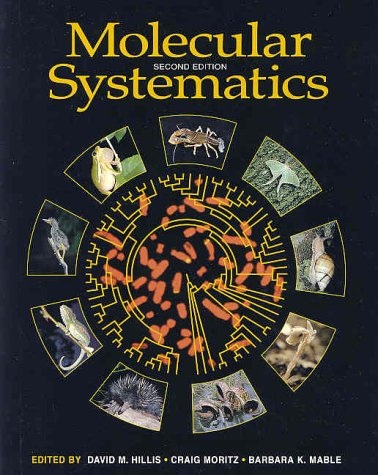
Here is yet another version from Hannah Udelll at the University of Wisconson-Madisson. In this version, the tattoo artist used stippling and included the full tree, but stippled the species names for an artistic look.

From the exhibit Massive
Change:The Future of Global Design:
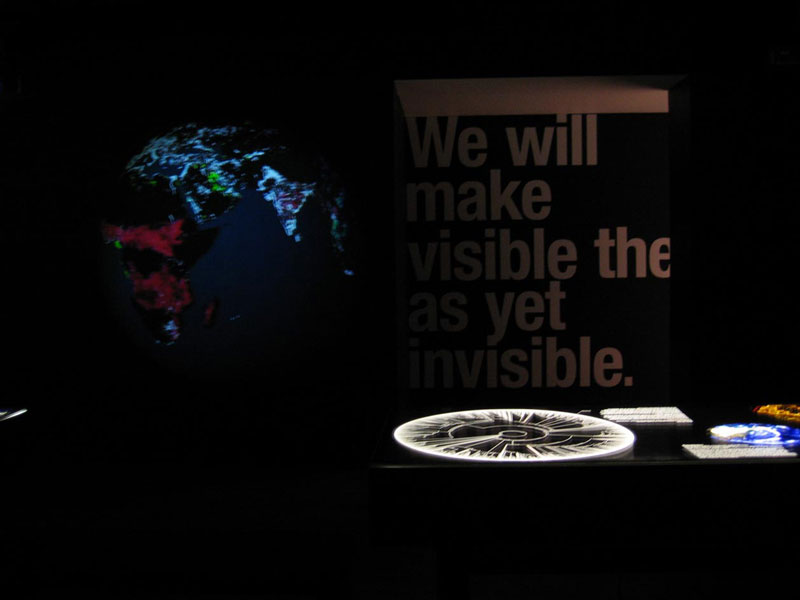
Here is a version modified by artist Carol Ballenger, commissioned by a hospital:
In La Caruña, Spain, two teachers in a secondary school, Enrique Santillán and Teodoro Rodríguez, worked with their students to build
a modified version of this tree to explain the Tree of Life to the public. Here is their description of the project, and a few photographs
from their clever educational project:
"We made a large format impression, fixed it on an oversized (2.10 m. in diameter) wood circle with a steel harness behind that
allowed it to rotate over a central axis, and installed two fixed magnifying lenses to let people read the writing comfortably. In addition,
we fixed a pannel with a ... mention of the International Year of Biodiversity, and around thirty images of different representative
species.In the fair, our students did an excellent job explaining the tree to the attendants and we collected effusive comments from
the general public (mainly surprised by the fact of being so close to mice, the enormous amount of species and the connections
between them) as well as from the experts (for the level of knowledge of our students and the development of the experience)."
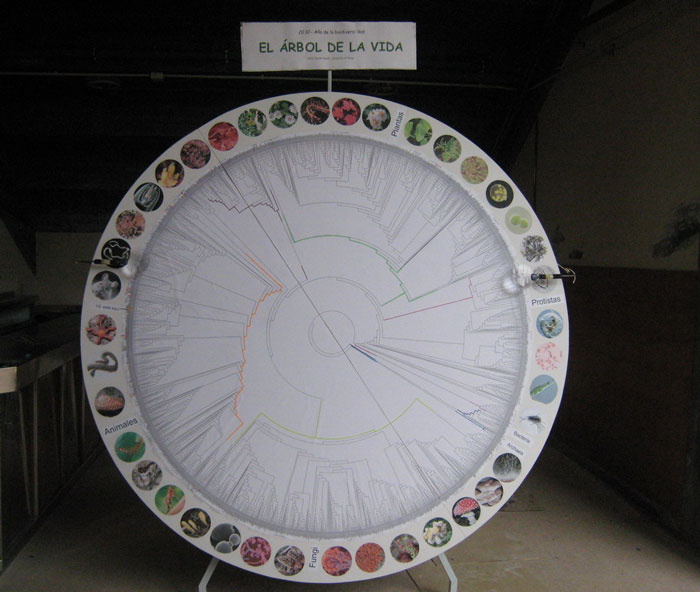
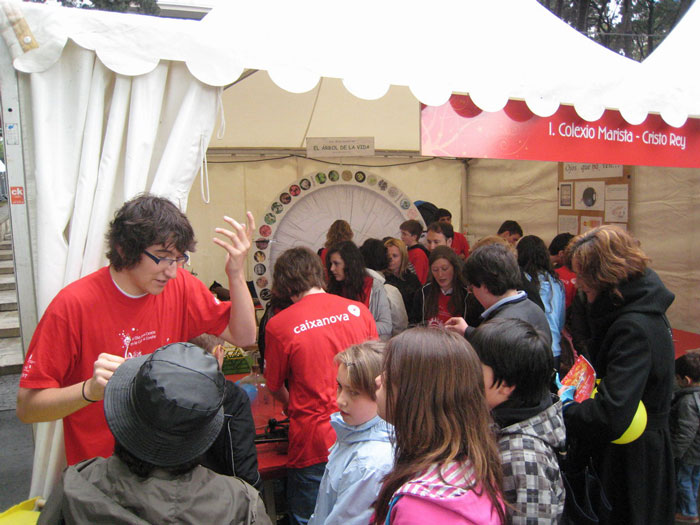
This figure has been printed and used in many places. I was happy to see its use in the offices of the School of Biological Sciences at the University of Nebraska:

At the Mind Museum in the Philippines (below), they have produced an exhibit their Life Gallery about the Tree of Life.
Kai Pobre, the Exhibit Manager, explains the exhibit: "We have the Hillis Plot at the tree trunk [etched in wood] where guests can read the names of the various species through a magnifying glass. Above it is a video that shows the Theories on How Life Began. The tree [growing up from the plot] is made of metal showing the branching of Archea, Bacteria and Eukaryotes while the organisms are made of resin cocoons and sculptured wires."
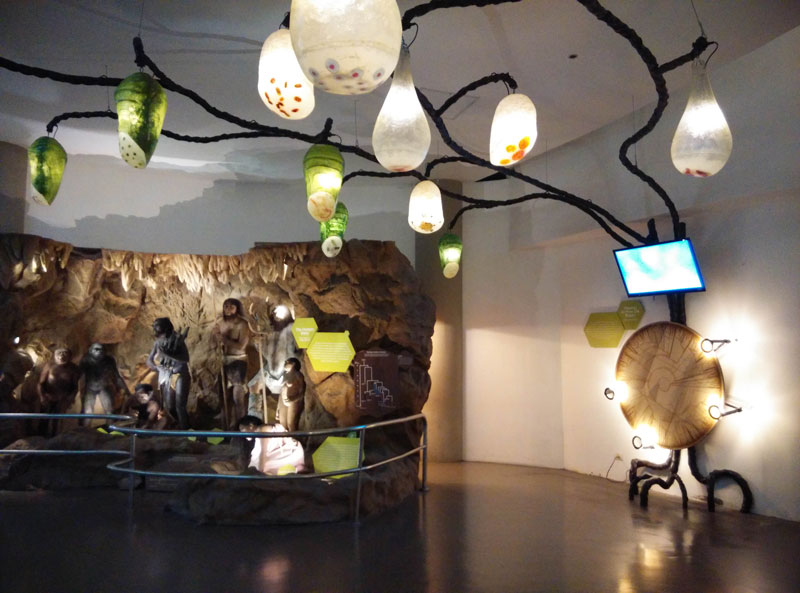
Below is a simplified version of the Tree of Life, showing common names of the major groups. This version of the tree
is based on the Tree of Life appendix in Life: The Science of Biology, 9th ed.,
by D. Sadava, D. M. Hillis, H. C. Heller, and M. Berenbaum (Sinauer Associates and W. H. Freeman, 2011).
An interactive version of this tree can be found at the Life website. Clicking on taxon names in the interactive version will show
a description of the group, provide links to information about the various taxa (including photographs, lists of species, range maps, etc.),
and highlight the respective clade on the tree.
The pdf for this file is 35 kb.

This one has made it into tattoos as well, as on this unlabled arm tattoo (courtesy of Joel Klinepeter).
Notice the asterisk, signifying "You are here!"
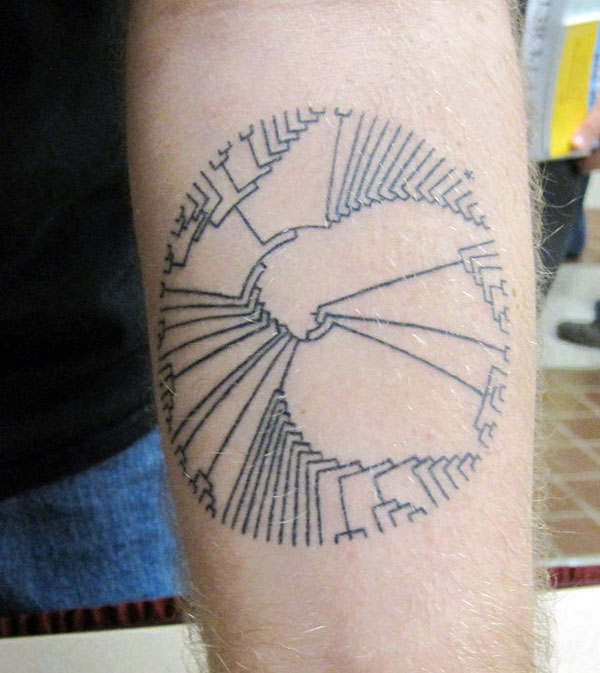
Return to "Download Files" Page
| Current Hillis Lab | Visit the Double Helix Ranch | Lab Genealogy | Former Students and Postdocs |

